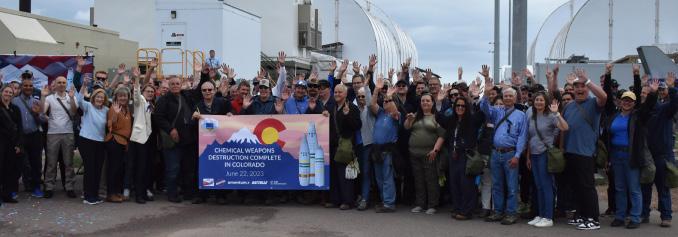
1 minute read
Mission accomplished
Pueblo Chemical Depot, demilitarization plant look to the future after destroying mustard munitions
By Ben Cason
Advertisement
One morning in late June, hundreds of employees at the Pueblo Chemical Agent-Destruction Pilot Plant gathered to celebrate the destruction of the final munition in the obsolete stockpile at the U.S. Army Pueblo Chemical Depot.

Kim Jackson, PCAPP’s Amentum vice president, addressed the crowd in the final moments before completion: “Today we celebrate PCAPP finishing its mission. It’s all thanks to the courageous, extraordinary men and women of this project.”
Historic mission
Located on the eastern plains of Pueblo, the depot has been in use since 1942. From the end of World War II and into the 1950s, facilities were expanded and constructed to continue to support the Korean War. The depot was one of the largest employers in southern Colorado with 8,000 employees at one time.
In 1952, the first mustard-agent-filled munitions were shipped to the depot for storage. The Army stored approximately 8% of the nation’s original chemical stockpile. In total, the Pueblo Chemical Depot stored 780,078 munitions, containing 2,613 tons of mustard agent configured in projectiles and mortar rounds. By 1995, after supporting Operation Desert Storm with conventional ammunition and supplies, the depot was significantly downsized.
Mustard is a blistering agent designed to produce casualties, degrade fighting ef- ficiency and restrict use of terrain and equipment. It affects the eyes, mucous membranes, lungs, skin and blood-forming organs. Mustard agent can be fatal, depending on the severity of exposure.
In Pueblo, the mustard agent was stored in three types of munitions. The first was the large 155mm projectile, which was 99 pounds and 26.8 inches long. Nearly 300,000 of these projectiles were stored at the Pueblo Chemical Depot. The second largest munition was the 105mm projectile, which was 32 pounds and 21 inches long. The smallest munitions stored in the depot were the 4.2-inch mortar rounds, steelforged, at 25 pounds and 21 inches long.
On April 29, 1997, the Chemical Weapons Convention went into force. At that time, the U.S. and 86 other nations were the first to ratify the CWC. Now, the treaty has been signed by 193 nations, and is enforced by the Organisation for the Prohibition of Chemical Weapons in The Hague, Netherlands.
“[The CWC] has been incredibly successful in its overriding mission and goal to destroy remaining stockpiles of chemical weapons,” said Kingston Reif, the Deputy Assistant Secretary of Defense for Threat Reduction and Arms Control, at a PCAPP media tour earlier in June. “There are only four states that are not party to the convention. At the moment 99% of the declared stockpiles under the convention have
DEPOT continued on page #








